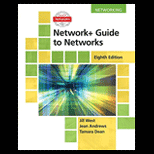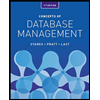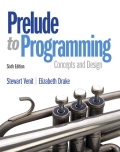
Computer Networking: A Top-Down Approach (7th Edition)
7th Edition
ISBN: 9780133594140
Author: James Kurose, Keith Ross
Publisher: PEARSON
expand_more
expand_more
format_list_bulleted
Question
Please use Java, include comments in the code, and explain what the code is doing. Problem is in the photos.
![**Title: Detecting Cycles in a Graph Using Java**
**Objective:**
This tutorial guides you through writing a Java program to detect cycles in a graph using a data file structure. This approach is particularly useful for examining connected graphs that can be represented as trees.
**Definitions:**
- **Cycle in a Graph:** This occurs if there is a back edge present. A back edge connects a node to itself (self-loop) or to one of its ancestors in the graph structure.
- **Back Edge:** An edge linking a node to an ancestor node in the tree, indicating a cycle.
**Algorithm:**
1. **Graph Creation:**
- Begin by constructing the graph using a specified number of edges and vertices.
2. **Recursive Function:**
- Implement a recursive function that accepts the current index (vertex), a visited tracker, and a recursion stack.
3. **Mark Visited Nodes:**
- As you traverse, mark the current node as visited.
- Additionally, record the node in the recursion stack.
4. **Explore Adjacent Vertices:**
- Identify all unvisited vertices adjacent to the current node.
- Recursively call the function on these vertices.
- If a recursive call detects a cycle, return `true`.
5. **Check for Back Edges:**
- If adjacent vertices are already in the recursion stack, a cycle exists. Return `true`.
6. **Wrapper Class:**
- Design a wrapper class to execute the recursive function for all vertices.
- If any vertex function returns `true`, confirm a cycle and return `true`.
7. **Cycle Absence:**
- If the function finishes and no cycles are found, return `false`.
**Graph Explanation:**
- **Adjacency List Representation:**
- Node 0: 1, 2, 3
- Node 1: 0, 2
- Node 2: 0, 1
- Node 3: 0, 4
- Node 4: 3
- **Cycle Detection Flowchart:**
- Start with `isCyclicUtil(0, -1)`, marking `vis[0] = true`.
- Move to `isCyclicUtil(1, 0)`, marking `vis[1] = true`.
- No cycle if moving back to `vis[0]` as it](https://content.bartleby.com/qna-images/question/4cd5838b-3f34-487e-9642-7770197fe05c/8a199797-f76a-4e42-b87e-81327550e68b/if0rav9_thumbnail.png)
Transcribed Image Text:**Title: Detecting Cycles in a Graph Using Java**
**Objective:**
This tutorial guides you through writing a Java program to detect cycles in a graph using a data file structure. This approach is particularly useful for examining connected graphs that can be represented as trees.
**Definitions:**
- **Cycle in a Graph:** This occurs if there is a back edge present. A back edge connects a node to itself (self-loop) or to one of its ancestors in the graph structure.
- **Back Edge:** An edge linking a node to an ancestor node in the tree, indicating a cycle.
**Algorithm:**
1. **Graph Creation:**
- Begin by constructing the graph using a specified number of edges and vertices.
2. **Recursive Function:**
- Implement a recursive function that accepts the current index (vertex), a visited tracker, and a recursion stack.
3. **Mark Visited Nodes:**
- As you traverse, mark the current node as visited.
- Additionally, record the node in the recursion stack.
4. **Explore Adjacent Vertices:**
- Identify all unvisited vertices adjacent to the current node.
- Recursively call the function on these vertices.
- If a recursive call detects a cycle, return `true`.
5. **Check for Back Edges:**
- If adjacent vertices are already in the recursion stack, a cycle exists. Return `true`.
6. **Wrapper Class:**
- Design a wrapper class to execute the recursive function for all vertices.
- If any vertex function returns `true`, confirm a cycle and return `true`.
7. **Cycle Absence:**
- If the function finishes and no cycles are found, return `false`.
**Graph Explanation:**
- **Adjacency List Representation:**
- Node 0: 1, 2, 3
- Node 1: 0, 2
- Node 2: 0, 1
- Node 3: 0, 4
- Node 4: 3
- **Cycle Detection Flowchart:**
- Start with `isCyclicUtil(0, -1)`, marking `vis[0] = true`.
- Move to `isCyclicUtil(1, 0)`, marking `vis[1] = true`.
- No cycle if moving back to `vis[0]` as it
![```java
import java.io.*;
import java.util.*;
// This class represents a
// directed graph using adjacent list Representation.
class Graph
{
// No. of vertices
private int V;
// Adjacency List Representation
private LinkedList<Integer> adj[];
// Constructor
Graph(int v)
{
V = v;
adj = new LinkedList[v];
for(int i=0; i<v; ++i)
adj[i] = new LinkedList();
}
Your code continues below
}
```
### Explanation:
This Java code is part of a program to create a directed graph using an adjacency list representation:
- **Imports**:
- `import java.io.*;`
- `import java.util.*;`
- These imports bring in I/O and utility libraries required for various operations.
- **Class Definition**: `class Graph`
- Represents a graph structure.
- **Attributes**:
- `private int V;`: Stores the number of vertices in the graph.
- `private LinkedList<Integer> adj[];`: An array of linked lists to store the adjacency list of the graph.
- **Constructor**:
- `Graph(int v)`: Initializes a new graph with `v` vertices.
- `V = v;`: Sets the number of vertices.
- `adj = new LinkedList[v];`: Initializes the adjacency list array.
- The `for` loop initializes each element of the adjacency list as a new linked list for storing neighboring vertices.
This is a foundational setup commonly used for graph data structures in computer science education, particularly for illustrating graph algorithms.](https://content.bartleby.com/qna-images/question/4cd5838b-3f34-487e-9642-7770197fe05c/8a199797-f76a-4e42-b87e-81327550e68b/u34y0w_thumbnail.png)
Transcribed Image Text:```java
import java.io.*;
import java.util.*;
// This class represents a
// directed graph using adjacent list Representation.
class Graph
{
// No. of vertices
private int V;
// Adjacency List Representation
private LinkedList<Integer> adj[];
// Constructor
Graph(int v)
{
V = v;
adj = new LinkedList[v];
for(int i=0; i<v; ++i)
adj[i] = new LinkedList();
}
Your code continues below
}
```
### Explanation:
This Java code is part of a program to create a directed graph using an adjacency list representation:
- **Imports**:
- `import java.io.*;`
- `import java.util.*;`
- These imports bring in I/O and utility libraries required for various operations.
- **Class Definition**: `class Graph`
- Represents a graph structure.
- **Attributes**:
- `private int V;`: Stores the number of vertices in the graph.
- `private LinkedList<Integer> adj[];`: An array of linked lists to store the adjacency list of the graph.
- **Constructor**:
- `Graph(int v)`: Initializes a new graph with `v` vertices.
- `V = v;`: Sets the number of vertices.
- `adj = new LinkedList[v];`: Initializes the adjacency list array.
- The `for` loop initializes each element of the adjacency list as a new linked list for storing neighboring vertices.
This is a foundational setup commonly used for graph data structures in computer science education, particularly for illustrating graph algorithms.
Expert Solution
This question has been solved!
Explore an expertly crafted, step-by-step solution for a thorough understanding of key concepts.
This is a popular solution
Trending nowThis is a popular solution!
Step by stepSolved in 4 steps with 5 images

Knowledge Booster
Similar questions
- Thank you very much for your help. I do need the btnSubmitPrice to work when clicked though, and via the assignment given, I cannot have an InputBox unless I am also allowed to have the btnSubmitPrice to be clicked when a user adds another item. When a user adds another item, the txtTotalSales and txtAverageSalePrice have to change as well and update with the new values. I do not know how to do this. I tried moving the text under btnSubmitPrice_Click instead of FrmMain_Load and it did not work.arrow_forwardIs that so? The default value of the text field is the form's name.arrow_forwardPlease help me with this using javaarrow_forward
- 12. Solar System. In Python,use a Canvas widget to draw each of the planets of our solar system. Draw the sun first, then each planet according to distance from the sun (Mercury, Venus, Earth, Mars, Jupiter Saturn, Uranus, Neptune, and the dwarf planet, Pluto). Label each planet using the create_text method.arrow_forwardComplete the code with if statement(s) to solve this problem? Print the message "charge your phone" if you have a charger and battery level is 15% or less. Print "Charge your phone when your charger s is available." if the battery is 15% or less and you don't have a charger. Print "Your battery is charged" if the battery level is more than 15%. Please set the font in the text editor to Courier New to make it easier for code to line up. 1 charger_available = True 2 battery_level = 0.15 3 4 7 10 Charge your phone.arrow_forwardIs it so, or am I wrong? The Text element of a newly generated form initially contains the name of the form. This is done at the beginning of the setup process.arrow_forward
- simply fill in the blanks. To make it easier for you to enter the number, you may simply enter the number without having to indicate the base using the subscript. For example, you may enter AF instead of AFsixteen: Fill in the blanks. Provide the number immediately before and after the given number in the given base, respectively. No work to be shown for this problem. You may Click on Show Rich-Text Editor option for more formatting tools, such as subscript. 8D9FFsixteen. 1. F8DAOsixteen, 2. 3. 57100eight 4. , 100110000two, 4200seven, 5.arrow_forwardUsing square braces. In the previous question you had used the dot notation to add key values in an object and in this you have to add squares braces and print the object before and after addingarrow_forwardCan you please answer the following question? The program is JavaScript and needs to look exactly like the example attached. Thanks!arrow_forward
- Please fix these in the above splution, it is not fully correct. "You're invited" needs to be formatted correctly. With a larger font, using BS classes only. Use Bootstrap classes to make a circular image with a border - around the image only. "Don't tell the cats" color should be set with BS classes.arrow_forwardCounting the growth rings of a tree is a good way to tell the age of a tree. Each growth ring counts as one year. Use a Canvas widget to draw how the growth rings of a 5-year-old tree might look. Then, using the create_text method, number each growth ring starting from the center and working outward with the age in years associated with that ring.arrow_forwardUsing DrawingPanel.java (from chapter 3G), draw a grid for filling in a 4 x 4 square of cell containing integers. For this part of the assignment the values are not important, but you are welcome to use the values shown in the magic square from below. Note that the values in any horizontal row, vertical column or main diagonals add up to 34, in addition to various sub-squares in the larger square also add up to the same value. Requirements: The magic square should be centered in the panel The values in each of the cells should be centered in that cell (both horizontally and vertically). You can assume the values will be <= 99 (i.e., at most 2 digits). For this part of the assignment, you can hard-code the values; you will store them in a 2-dimensional array (from chapter 7) when implementing Part B of the assignment. The title "CSC 142 Magic Square" is centered horizontally in the panel and at y = 50 You are free to choose the colors, fonts, font sizes and effects. This is what I used…arrow_forward
arrow_back_ios
SEE MORE QUESTIONS
arrow_forward_ios
Recommended textbooks for you
 Computer Networking: A Top-Down Approach (7th Edi...Computer EngineeringISBN:9780133594140Author:James Kurose, Keith RossPublisher:PEARSON
Computer Networking: A Top-Down Approach (7th Edi...Computer EngineeringISBN:9780133594140Author:James Kurose, Keith RossPublisher:PEARSON Computer Organization and Design MIPS Edition, Fi...Computer EngineeringISBN:9780124077263Author:David A. Patterson, John L. HennessyPublisher:Elsevier Science
Computer Organization and Design MIPS Edition, Fi...Computer EngineeringISBN:9780124077263Author:David A. Patterson, John L. HennessyPublisher:Elsevier Science Network+ Guide to Networks (MindTap Course List)Computer EngineeringISBN:9781337569330Author:Jill West, Tamara Dean, Jean AndrewsPublisher:Cengage Learning
Network+ Guide to Networks (MindTap Course List)Computer EngineeringISBN:9781337569330Author:Jill West, Tamara Dean, Jean AndrewsPublisher:Cengage Learning Concepts of Database ManagementComputer EngineeringISBN:9781337093422Author:Joy L. Starks, Philip J. Pratt, Mary Z. LastPublisher:Cengage Learning
Concepts of Database ManagementComputer EngineeringISBN:9781337093422Author:Joy L. Starks, Philip J. Pratt, Mary Z. LastPublisher:Cengage Learning Prelude to ProgrammingComputer EngineeringISBN:9780133750423Author:VENIT, StewartPublisher:Pearson Education
Prelude to ProgrammingComputer EngineeringISBN:9780133750423Author:VENIT, StewartPublisher:Pearson Education Sc Business Data Communications and Networking, T...Computer EngineeringISBN:9781119368830Author:FITZGERALDPublisher:WILEY
Sc Business Data Communications and Networking, T...Computer EngineeringISBN:9781119368830Author:FITZGERALDPublisher:WILEY

Computer Networking: A Top-Down Approach (7th Edi...
Computer Engineering
ISBN:9780133594140
Author:James Kurose, Keith Ross
Publisher:PEARSON

Computer Organization and Design MIPS Edition, Fi...
Computer Engineering
ISBN:9780124077263
Author:David A. Patterson, John L. Hennessy
Publisher:Elsevier Science

Network+ Guide to Networks (MindTap Course List)
Computer Engineering
ISBN:9781337569330
Author:Jill West, Tamara Dean, Jean Andrews
Publisher:Cengage Learning

Concepts of Database Management
Computer Engineering
ISBN:9781337093422
Author:Joy L. Starks, Philip J. Pratt, Mary Z. Last
Publisher:Cengage Learning

Prelude to Programming
Computer Engineering
ISBN:9780133750423
Author:VENIT, Stewart
Publisher:Pearson Education

Sc Business Data Communications and Networking, T...
Computer Engineering
ISBN:9781119368830
Author:FITZGERALD
Publisher:WILEY